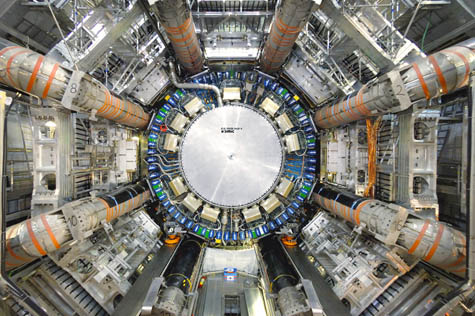Underground Rivers Frozen in Place
 [Image: The Large Hadron Collider photographed by Claudia Marcelloni, ©CERN, via The Big Picture].
[Image: The Large Hadron Collider photographed by Claudia Marcelloni, ©CERN, via The Big Picture].One of the most interesting engineering details from the construction of the Large Hadron Collider (LHC) is the fact that they had to freeze an underground river in place, using liquid nitrogen, in order to assemble the detector. This allowed them "to create a permafrost medium through which they could drill out the massive underground caverns" in which the LHC would then sit, the Independent reported back in 2003.
But London's got some underground rivers; they should do this there and create a subterranean skating rink.
A huge cube of ice beneath Los Angeles that's then melted slowly, over four decades, to form the city's water supply.
Meanwhile, the actual magnets of the collider itself "must be cooled to within a couple of degrees of 'absolute zero,'" we read, "the theoretical limit for how cold anything can get. This requires a constant supply of liquid helium pumped down from eight over-ground refrigeration plants – about 400,000 liters per year in total."
This temporary refrigeration of the planet reminds me of at least two things: 1) the so-called "freeze wall," no less than 30-feet thick, being constructed by Shell underground in the American Rockies as a way to access oil shale deposits, and 2) the constantly refrigerated underground mines of South Africa.
A crazed billionaire installs a pipework labyrinth of liquid helium pumps beneath his home in Barcelona – and he proceeds to create a subterranean glacier inside the faults of the earth itself, freezing the soil down to a depth of six miles and altering the local climate, before carving a spectacular series of show caves out of the permafrost, wearing Antarctic expedition gear, armed with remote control micro-tunneling machines.





Comments are moderated.
If it's not spam, it will appear here shortly!
That seems to be a very old kind of tradition, in Paris they had to do something similar to build the Saint Michel underground station at the start of last century. No nitrogen though, just ammonia galore.
This information on underground rivers and how people have interacted with them is amazing. I'd love more information on each segment.
Was just reading something on the shortage of helium, and it sounds like this may be one of the causes.
Didn't realize that Amarillo TX was the "Helium Capital of the World" either...
http://www.blm.gov/pgdata/etc/medialib/blm/nm/programs/0/helium_images.Par.71814.Image.-1.-1.1.jpg
Ethan
This reminds me, in a way of the Cueva de los Cristales. A temporary, deadly wonder.
http://www.ironammonite.com/2009/12/surviving-cueva-de-los-cristales-giant.html
Post a Comment